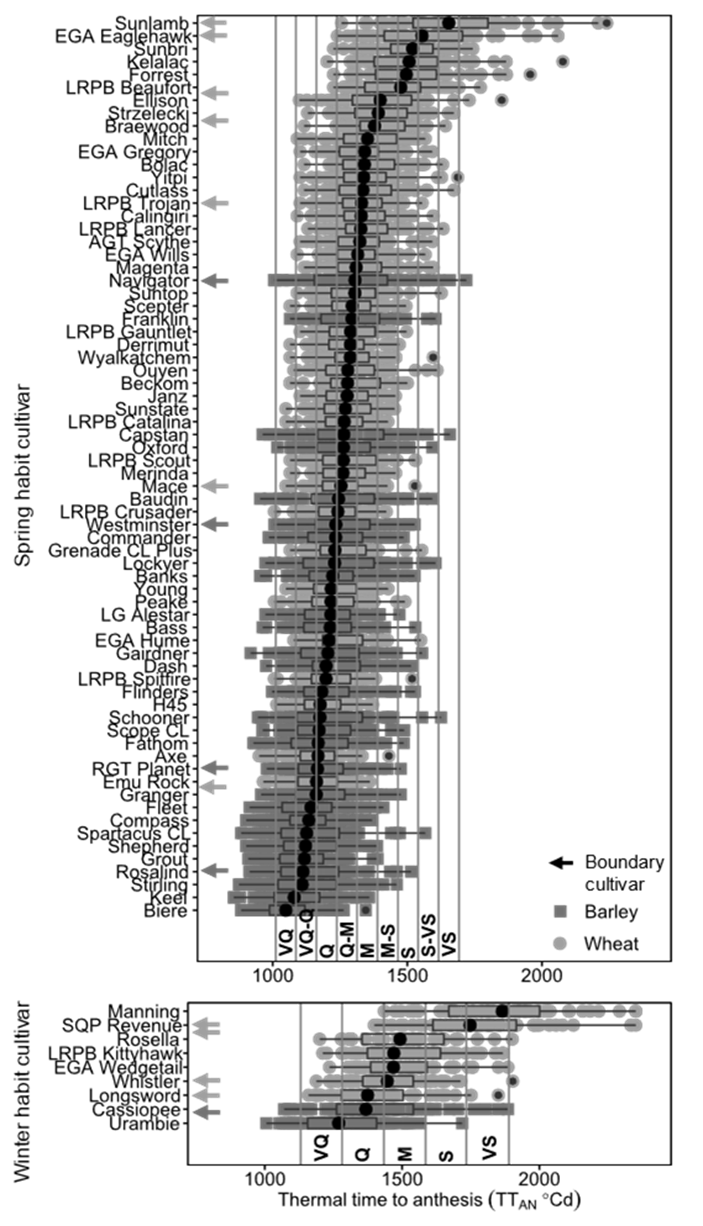Introducing the Australian Cereal Phenology Classification (ACPC) scheme for wheat and barley
Introducing the Australian Cereal Phenology Classification (ACPC) scheme for wheat and barley
Take home messages
- A new phenology classification scheme was created for wheat and barley cultivars.
- The scheme was derived and validated using genotype (70 wheat, 30 barley) × environment (QLD, WA, SA, VIC, NSW) × management (sowing dates from 1 March to 15 June) field experiments conducted across Australia.
- The scheme provides a standard approach to describing development based on thermal time to heading that can give consistency to descriptions provided by breeding companies.
- This phenology classification methodology can be extended internationally and to other crops.
Introducing the Australian Cereal Phenology Classification (ACPC)
Until recently, there have been no nationally accepted industry standards for describing cereal phenology. This has frequently led to misclassification, confusion and difficulties with making informed decisions regarding cultivar selection and time of sowing. In 2020, Australian Crop Breeders Pty Ltd published ‘An industry guide for wheat variety maturity description’ (‘ACB Guide’). The guide used relative heading dates of locally adapted cultivars planted at their target sowing dates to classify wheat varieties into nine spring and three winter classes. The ACB Guide represented an important step forward for the grains industry.
As part of the GRDC National Phenology Initiative, the 2020 ACB Guide was revised and extended to make it more robust, agronomically functional and meaningful to industry. A new cultivar phenology classification scheme for wheat and barley – the Australian Cereal Phenology Classification (ACPC) – has now been published and is available to industry. The ACPC was derived and validated using a phenological data set with a diverse array of genotypes (70 wheat and 30 barley), environments (WA, SA, VIC, NSW and QLD) and management (sowing dates from 1 March to 15 June). The development of the ACPC is described in full in Celestina et al. (2023). In brief:
- Thermal time to heading data were collected from national field experiments
- Wheat and barley data were combined, cultivars were split into winter or spring habit, and then ranked from quickest to slowest by median thermal time from sowing to anthesis
- Spring and winter habit cultivars were separated into equidistant classes that encompassed the range of phenology observed
- Cultivars corresponding to the boundary between neighbouring classes were selected.
A visual representation of the ACPC showing the phenology of wheat and barley cultivars studied and the location of the classes and boundary cultivars is shown in Figure 1.
The classes and boundary cultivars that define the ACPC can be seen in Table 1. Wheat and barley cultivars are divided into nine spring classes and five winter classes from quickest to slowest. In spring cultivars, these classes correspond to a change in optimal sowing date of about one week.
Note that phenology classifications according to the ACPC are only applicable to cultivars sown at the optimal time in a region to which they are adapted. When sown outside their optimal period, cultivars are likely to change rank (and therefore class) with sowing time and environment. This is particularly true of winter and facultative spring cultivars.

Figure 1. Model of the Australian Cereal Phenology Classification (ACPC) derived from the GRDC National Phenology Initiative G×E×M experiments. Cultivars are ranked from quickest to slowest according to median thermal time from sowing to heading. Vertical lines indicate the division of spring and winter cultivars into classification groupings. Arrows indicate the location of wheat and barley boundary cultivars separating each class. VQ, Very Quick; VQ-Q, Very Quick-Quick; Q, Quick; Q-M, Quick-Mid; M, Mid; M-S, Mid-Slow; S, Slow; S-VS, Slow-Very Slow; VS, Very Slow.
Table 1: Classes and boundary cultivars in the Australian Cereal Phenology Classification (ACPC).
Wheat | Barley | |||
|---|---|---|---|---|
Spring | Quick boundary | Slow boundary | Quick boundary | Slow boundary |
Very Quick (VQ) | < Rosalind | |||
Very Quick-Quick (VQ-Q) | < LRPB Dart | ≥ Rosalind | < RGT Planet | |
Quick (Q) | ≥ LRPB Dart | < Mace | ≥ RGT Planet | < Westminster |
Quick-Mid (Q-M) | ≥ Mace | < LRPB Trojan | ≥ Westminster | < Navigator |
Mid (M) | ≥ LRPB Trojan | < Coolah | ≥ Navigator | |
Mid-Slow (M-S) | ≥ Coolah | < RGT Zanzibar | ||
Slow (S) | ≥ RGT Zanzibar | < EGA Eaglehawk | ||
Slow-Very Slow (S-VS) | ≥ EGA Eaglehawk | < Sunlamb | ||
Very Slow (VS) | ≥ Sunlamb | |||
Winter | Quick boundary | Slow boundary | Quick boundary | Slow boundary |
Very Quick (VQ) | < Longsword | < Cassiopee | ||
Quick (Q) | ≥ Longsword | < Whistler | ≥ Cassiopee | |
Mid (M) | ≥ Whistler | < DS Bennett | ||
Slow (S) | ≥ DS Bennett | < SQP Revenue | ||
Very Slow (VS) | ≥ SQP Revenue | |||
How to classify new cultivars according to the ACPC
To classify a newly-released cultivar according to the ACPC, the phenology of the new cultivar must be assessed relative to that of the boundary cultivars across a range of environments and times of sowing to which the cultivar is adapted. Multiple site-years of data are required for accurate classification because heading date can vary substantially across latitudes, seasonal conditions and sowing dates.
To classify a new cultivar according to the ACPC:
- conduct a field experiment with the new cultivar and the boundary cultivars of that species
- collect data on head emergence and air temperature
- for every plot, calculate the 50% heading date and the thermal time from sowing to 50% heading
- calculate the median thermal time from sowing to heading for every cultivar
- rank the cultivars from quickest to slowest by median thermal time to heading
- assign a classification to the new cultivar based on where it is ranked relative to the boundary cultivars
- repeat this process for every site-year
- determine the overall classification for that cultivar based on the most common classification across all site-years.
For accurate measurements of crop development in a population of plants, heading should be measured as per Celestina et al. (2023), whereby a subset of plants in each plot is tagged and monitored twice a week to record the number of fertile culms that have the spike fully emerged with the peduncle visible (for wheat) or the awns visible above the flag leaf ligule (for barley). The 50% heading date is calculated as the date on which half of all spikes in the sample area have headed, and then thermal time from sowing date to heading date is calculated as the cumulative average daily air temperature, adjusted for species-specific cardinal temperatures as per Celestina et al. (2023).
Case study: classifying new wheat and barley cultivars
Data from field experiments carried out in New South Wales in 2021–2022 were used to classify some of the more recent wheat and barley cultivars released to market. There were 45 wheat and 16 barley cultivars, around half of which had not previously been classified according to the new ACPC scheme. Spring cultivars were sown at Breeza (2021), Condobolin (2021–2022) and Dirnaseer (2021–2022) across three times of sowing from 22 April to 16 June, and winter cultivars were sown at Wagga Wagga (2021–2022) at three times of sowing from 10 March to 25 April.
The protocol above was used, whereby new cultivars were compared to the boundary cultivars at multiple site-years and then the most common classification assigned. Note that these experiments used the original boundary cultivars published in the ACB Guide (2020), so the ranking and classification shown in Figure 2 is tentative and may be subject to change with more data. However, although some cultivars may change classes, they generally only move +/- one class and so the implication for cultivar selection and time of sowing decisions is minimal.
Figure 2 shows the overall phenology classification of each cultivar based on the most common classification for that cultivar across all site-years. The thermal time to heading of previously unclassified spring barley cultivars ranged from Beast (VQ) to Nitro (Q), but most were classed as VQ-Q between the boundary cultivars Rosalind (VQ-Q) and RGT Planet (Q). Previously unclassified spring wheat cultivars ranged from Borlaug 100 (Q) to Valiant CL Plus (M-S), with most falling in the middle of the range on either side of LRPB Trojan (M) and Coolah (M-S). All unclassified winter wheats were determined to be slower than DS Bennett (S). These classifications now need to be validated by assessing their phenology relative to that of the ACPC boundary cultivars.

Figure 2. Cultivars in the 2021–2022 field experiments conducted in Breeza, Dirnaseer, Condobolin and Wagga Wagga classified according to the Australian Cereal Phenology Classification (ACPC). Cultivars are ranked from quickest to slowest according to their overall phenology classification across all site-years. VQ, Very Quick; VQ-Q, Very Quick-Quick; Q, Quick; Q-M, Quick-Mid; M, Mid; M-S, Mid-Slow; S, Slow; S-VS, Slow-Very Slow; VS, Very Slow.
Conclusion
The Australian Cereal Phenology Classification (ACPC) has been derived from a dataset representing the full diversity of G×E×M for wheat and barley in the grain producing regions of Australia. This classification scheme will help growers better match crop life cycle to seasonal conditions in their environment, maximise yields achieved with new cultivar releases, and reduce confusion across regions. The same methodology used to derive the ACPC can be applied to other cereals and crop species to standardise descriptions of crop phenology across Australia.
Acknowledgements
The research undertaken as part of this project is made possible by the significant contributions of growers through both trial cooperation and the support of the GRDC, the author would like to thank them for their continued support. The authors would also like to acknowledge NSW DPI and QDAFF who were part of the Grains Agronomy and Pathology Partnership.
References
ACB (2020) ‘An industry guide for wheat variety maturity description.’ (Australian Crop Breeders Ltd: Roseworthy).
Celestina C, Hunt J, Kuchel H, Harris F, Porker K, Biddulph B, Bloomfield M, McCallum M, Graham R, Matthews P, Aisthorpe D, Al-Yaseri G, Hyles J, Trevaskis B, Wang E, Zhao Z, Zheng B, Huth N, Brown H (2023a) A cultivar phenology classification scheme for wheat and barley. European Journal of Agronomy 143, 126732.
Celestina C, Hunt J, Brown H, Huth N, Andreucci M, Hochman Z, Bloomfield M, Porker K, McCallum M, Harris F, Matthews M, Biddulph B, Al-Yaseri G, Nicol D, Hyles J, Wang E, Zheng B, Zhao Z, Kohout M (2023b) Scales of development for wheat and barley specific to either single culms or a population of culms. European Journal of Agronomy (in press).
Contact details
Corinne Celestina
The University of Melbourne
0438 645 387
corinne.celestina@unimelb.edu.au
Felicity Harris
Charles Sturt University
0458 243 350
fharris@csu.edu.au
Varieties displaying this symbol beside them are protected under the Plant Breeders Rights Act 1994.
GRDC Project Code: ULA1806-003RMX, DPI1703-015BLX, DPI1706-012BLX,
